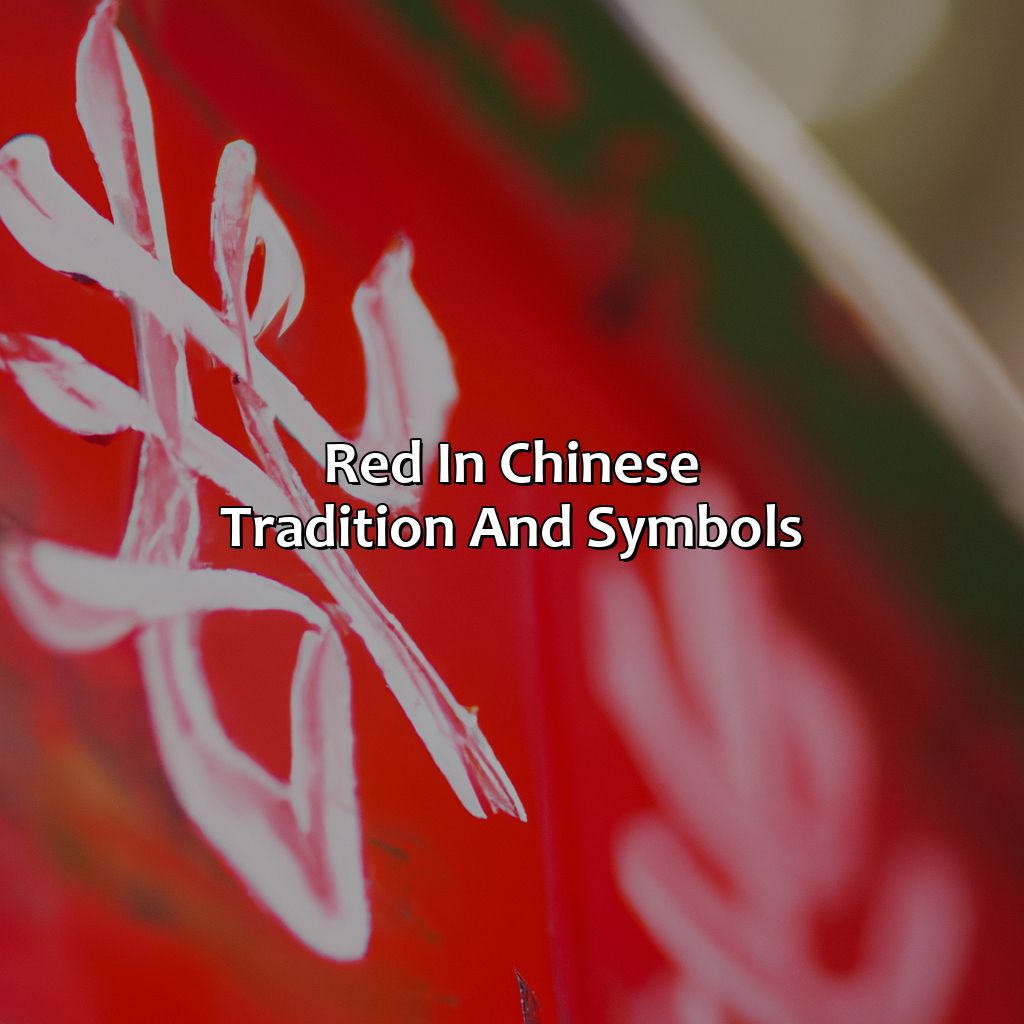Key Takeaways:
- The color red holds immense significance in Chinese culture as it symbolizes auspiciousness, luck, and fortune. It is commonly used during celebrations and festivals to bring in good luck and ward off evil spirits.
- Red has a rich history in Chinese culture and has been associated with imperial power, energy, authority, danger, and warning. It has been extensively used in literature, poetry, art, and even food to convey different meanings and symbolism.
- In traditional Chinese festivals such as Chinese New Year, red is used extensively to symbolize vitality, fire, passion, patriotism, and imperial power. It is also associated with the dragon, feng shui, and Qi.
The Significance of the Color Red in Chinese Culture

Photo Credits: colorscombo.com by Randy Roberts
To explore the symbolism and cultural significance of red in Chinese culture, take a look at the section on this. It has three subsections:
- Historical and Cultural Significance of Red in China
- Beliefs and Superstitions of Red in Chinese Culture
- Usage of Red in Traditional Chinese Festivals
These subsections explain the varying meanings of this color in Chinese traditions. From imperial power and patriotism to emotion and passion. Discover the colorful history and beliefs behind the auspicious color of red in China!
Historical and Cultural Significance of Red in China
The color red holds immense historical and cultural significance in Chinese society. In traditional China, the imperial family used red as a symbol of power and energy. Red is also associated with authority, but it can signify danger and warning as well. During the Cultural Revolution, red became an emblem of propaganda for the Communist political party. Red’s cultural roots run deep in history, tradition, literature, poetry, art, and even food in China.
Additionally, it’s important to note that beliefs and superstitions surrounding the color are still prevalent in modern Chinese culture. For example, during lunar New Year celebrations, one commonly hears fireworks being set off continuously throughout the night to ward off evil spirits whom they believe are frightened away by loud noises. Any celebratory event or life milestone is typically decorated using red as a lucky color.
Red holding important significance does not stop there; it has become a fixture within contemporary Chinese society. The Chinese fashion industry makes ample use of all shades of red clothing items like lingerie to rouge lipstick among many others. Similarly, businesses incorporate the color into their marketing campaigns to attract attention and create associations of prosperity such as brands like Alibaba or China Petroleum implementing this strategy successfully.
Pro Tip: If visiting China during festive times, bring along something red to take part in auspicious celebrations & observe how a single color brings together vast portions of this multi-faceted culture!
Red in Chinese culture is like a traffic light: it can mean stop, warning, or prohibition, but it can also represent love, passion, and excitement.
Beliefs and Superstitions of Red in Chinese Culture
The Significance of Red in Chinese Culture goes far beyond aesthetics; in fact, it has deep cultural and historical significance. Red represents good luck, happiness, and celebration. It is a symbol of emotion, love, passion, courage, and bravery. Furthermore, red also represents heat, anger, aggression, urgency, excitement, and stimulation.
In Chinese culture superstitions persist about the color red; unmarried women are expected to wear red because it represents happiness and good fortune in attracting potential suitors. Additionally, families hang red paper cuts or banners with auspicious phrases on their doors during Spring Festival to ward off evil spirits. The color red is also associated with vitality and happiness at weddings where guests will typically wear red to celebrate the occasion.
Red is a critical color that carries a warning or prohibition when used as a stop sign or traffic light signal for safety reasons. The color warns commuters to stop before proceeding further due to the danger ahead which draws urgency and excitement towards it creating an emotional bond between people’s minds and hearts thus affecting behavior tendencies positively.
The color red derives its importance from blood which signifies sentimentality and emotionality growing into playful selfishness making humans more pronounced by their feelings than a sense of logic. Red holds undeniable power making it an essential element in traditional festivals such as Lunar New Year celebrations where people wear their best red attire or gift money stuffed inside a traditional Hongbao envelope decorated with gold trimmings representing wealth.
Traditional Chinese festivals are a fiery celebration of red’s symbolism of vitality, imperial power, and patriotism – making the communist and national flags red was a no-brainer.
Usage of Red in Traditional Chinese Festivals
Red is extensively used in traditional Chinese festivals as it symbolizes wealth, prosperity, and good fortune. During the Chinese New Year, red clothes, decorations and envelopes with money are exchanged as a token of good luck, and to ward off evil spirits. Red is also associated with the zodiac sign of the dragon which portrays strength and power. Moreover, Feng Shui believes that using red colors in homes can attract good Qi or vitality.
Chinese festivals such as Qingming, Dragon Boat Festival and Mid-Autumn Festival use red for religious or cultural reasons. The fire element is considered auspicious and hence red-colored lanterns are hung during these festivals as they represent energy and passion. Red has imperial connotations since ancient times which make it a popular color among patriotic citizens. It’s no wonder that the Communist Party of China chose to have the Communist flag in red color just like their national flag- both representing power.
Interestingly enough, during these festivals national unity and patriotism are celebrated through songs like their national anthem “March of Volunteers.” The occasion of National Day sees elaborate fireworks display with predominantly red-colored fireworks filling up the sky symbolizing bravery and courage.
The usage of red in traditional Chinese festivals dates back to ancient periods where it was believed that demons despised this color making it desirable for protection against them. This belief later translated into using red clothing and symbols on important occasions showcasing vigor, heroism, seduction or femininity depending upon the context. Irrespective where you go in China today, one will be reminded of its rich history through any festive celebration where dripping hues or crimson become a tradition-the grandeur which remains an integral part of its culture till today!
From the Chinese zodiac to traditional medicine, the color red remains a symbol of luck, happiness, and prosperity in Chinese tradition.
Red in Chinese Tradition and Symbols

Photo Credits: colorscombo.com by Philip Nelson
To grasp the meaning of red in Chinese culture, look into the “Red in Chinese Tradition and Symbols” section. It has three subsections: “Red and the Chinese Zodiac,” “Red in Chinese Art and Calligraphy,” and “Symbolism of Red in Traditional Chinese Medicine.” All of these offer a different angle on the cultural importance of red in China. It’s included in art and medicine, among other things.
Red and the Chinese Zodiac
One significant aspect of Chinese culture is the significance of the color red. It is believed to bring good luck, fortune, and happiness in many Chinese customs. Red also plays an important role in the Chinese zodiac as each year is represented by a different animal, with their respective lucky colors. For example, the Year of the Dragon (which symbolizes vitality and energy) is traditionally associated with the color red.
In traditional Chinese astrology, various aspects – including personality traits and career choices – are attributed to each individual’s zodiac sign. The use of specific colors in various celebrations or events can be considered auspicious or lucky based on certain zodiac signs’ characteristics. Therefore, red is chosen for those born under the sign of Dragon.
Furthermore, The dragon’s embodiment with fire lends a powerful association between this auspicious creature and other things perceived as ‘fiery,’ such as red feverishly conveying China’s fervor-where it has become something more than just another bright hue in its flag-colored palette.
It’s time to take full advantage of these ancient beliefs by embracing Red into our lives too! Try using this vibrant color in your next project/widget/website/branding/clothing design & showcase your energetic self! From calligraphy to paintings, red is to Chinese art what bacon is to food – an essential ingredient that adds flavor and depth.
Red in Chinese Art and Calligraphy
The art of calligraphy is an integral part of Chinese culture, and red ink plays a prominent role in this tradition. Symbolizing passion, good luck, and happiness, red ink has been used in calligraphy for centuries. Through the bold strokes of a calligrapher’s brush, red ink transforms into poetic messages that echo throughout time. Chinese art is also known for its use of red, representing joy and celebration. The color motivates creativity in painting and sculpture, energizing artists to evoke intricate emotions through their expression. Red remains vital to storytelling in Chinese culture connecting emotion with imagery.
As one looks deeper into the traditional Chinese artwork, it becomes evident that each character has a symbolic representation beyond font design. The written character evokes rich meaning and cultural significance when displayed on the wall or painted on pottery using mineral pigments inspired by nature. The symbolism the characters hold tells your story allowing writers to add nuance when words are not enough.
Ancient artefacts depict how brushstrokes created beautifully rendered glosses introduced new techniques year after year invoking creativity by using complementary variations of color – like green at times or gold – while consistently using red as an accentuating color for impact.
In closing, the use of red within Chinese calligraphy has brought vibrancy and life to their artistic expressionism and their culture as a whole both historically & artistically alongside their relentless pursuit for excellence and preservation of their traditions over millennia.
Red isn’t just a color in traditional Chinese medicine, it’s a symbol of vital Qi, healthy blood flow, and emotional and sensual well-being.
Symbolism of Red in Traditional Chinese Medicine
The Symbolic Significance of Red Within Traditional Chinese Medicine
Red has a long-standing history in traditional Chinese medicine. In this practice, red represents vital energy or qi that flows within the body. It is associated with blood and is believed to harmonize and nourish the body’s blood and vital forces.
Red also plays an important role in understanding emotions, as it is associated with sensuality and passion. Within traditional Chinese medicine, imbalance or stagnation in the body’s qi can lead to negative emotional states such as anger or frustration.
In addition to its association with the body’s energetic systems, red is often used as a symbol of good health and vitality within traditional medicine practices. For example, many herbal remedies are formulated with ingredients that contain red pigments that reflect the herb’s ability to invigorate and energize the body.
For those looking to incorporate more vitality into their lives, practicing tai chi or qigong exercises can help regulate qi flow while reducing stress and promoting overall wellbeing. Additionally, incorporating antioxidant-rich foods like berries and pomegranates into one’s diet can help nourish the body’s internal systems for optimal health.
Red isn’t just a color in Chinese culture, it’s a symbol of power and prosperity that has infiltrated every aspect of modern society, from fashion and design to business and marketing.
Red in Modern Chinese Culture

Photo Credits: colorscombo.com by Ralph Green
Grasp the importance of red in present Chinese culture by exploring the realms of fashion, design, business, marketing, and society. Check out the subsections:
- ‘Red in Chinese Fashion and Design’
- ‘Red in Chinese Business and Marketing’
- ‘Red in Contemporary Chinese Society’
Gaining knowledge of the color’s cultural and historical meaning and the feelings it sparks.
Red in Chinese Fashion and Design
Red is a prominent color in Chinese fashion and design, symbolizing warmth, auspiciousness, and prosperity. It is often used to express elegance, luxury, and richness in high society. Creativity is also associated with the color red as it represents sensuality and eroticism. In modern times, red is used liberally in clothing designs, accessories, and cosmetics.
Chinese designers often incorporate traditional elements such as embroidery or brocade into their creations using red as a base color. Red gowns are a popular choice for brides as they symbolize luck and happiness. In recent years, designers have experimented with different shades of red to create unique palettes that diverge from traditional associations.
In addition to its use in clothing designs, the color red has also been utilized in modern architecture and product design. Red-colored furniture can evoke boldness or warmth depending on the shade used.
Fun fact: The use of red lipstick dates back to ancient China when it was worn to signify social status and wealth.
Red is the ultimate power color in Chinese business and marketing, evoking assertiveness, determination, ambition, creativity, and stimulation.
Red in Chinese Business and Marketing
Red is a popular color in Chinese business and marketing due to its association with success, prosperity, and good luck. It represents assertiveness, determination, ambition, creativity, and stimulation. Many Chinese companies use red extensively in their branding, advertising, and packaging to attract customers and create a strong brand identity. This color is prevalent in Chinese traditional symbolism as well where it shows up as the number one lucky color when used with gold.
Another reason for the popularity of red in Chinese business culture is its association with holidays such as the Lunar New Year. It is customary to exchange red envelopes filled with money as gifts during this celebration. Businesses also give out red envelopes to employees and clients for prosperity during the Lunar New Year.
In addition to these factors, many modern companies have adopted various shades of red for their branding purposes that match Western design trends while staying true to traditional Chinese values. The cultural importance of this color can be observed in various industries like food packaging labels, sports team logos, fashion accessories, etc.
A startup company that specialized in online sales found itself struggling until they hired a consultant who suggested changing their logo’s design by adding more shades of red which reflected prosperity according to traditional values associated with the color. This decision resulted in an increase of 35% sales within six months providing the company’s boasting confidence among its competitors.
Thus, the use of red has become an essential element for businesses and marketing strategies that want to appeal to China’s population by creating identities expressing success, progressiveness while maintaining their roots into traditional culture simultaneously. From fashion to business, the color red exudes confidence, vitality and assertiveness that reflects the passion and patriotism of contemporary Chinese society.
Red in Contemporary Chinese Society
Red holds immense significance in contemporary Chinese society, reflecting the enduring connection of Chinese culture with this vibrant hue. In modern times, red is found in many aspects of Chinese culture and lifestyle. The color’s symbolism is inseparably connected to vitality, happiness and confidence. Moreover, it denotes assertiveness as well as determination, imbuing people with a sense of patriotism, pride and energy.
Red represents the roots of communism in China. It embodies power and energy in political speeches and branding for political parties. Red symbolizes passion in advertising campaigns for sports teams or exercise equipment like treadmills or gym equipment. In New Year celebrations, red envelopes containing money are given as gifts to children around China to spread joy and happiness.
Pro Tip: When designing your marketing campaign or brand identity in China, consider using red colors strategically to evoke consumer emotions with an association of power, confidence and assertiveness.
Five Facts About What Does the Color Red Mean in Chinese Culture:
- ✅ Red is considered the most auspicious color in Chinese culture, symbolizing good fortune and happiness. (Source: CCTV)
- ✅ Red is often used in weddings, celebrations, and other joyous occasions in Chinese culture. (Source: China Daily)
- ✅ Red envelopes filled with money are given as gifts during Chinese New Year and other festive events. (Source: New York Times)
- ✅ Red is also associated with the Chinese Communist Party and is prominently featured in the country’s flag. (Source: Britannica)
- ✅ Using the color red in business can be seen as a symbol of strength, power, and success in Chinese culture. (Source: Harvard Business Review)
FAQs about What Does The Color Red Mean In Chinese Culture
What does the color red mean in Chinese culture?
The color red has a significant meaning in Chinese culture. It is commonly associated with luck, fortune, joy, and happiness. Red is believed to ward off evil spirits and bring good luck to people’s lives.
Why is the color red so important in Chinese culture?
The color red has a deep meaning in Chinese culture. It is a symbol of happiness, good luck, and prosperity. Red is widely used during the Chinese New Year, weddings, and other festive occasions to bring good fortune to people’s lives.
What are some examples of the use of the color red in Chinese culture?
The use of the color red is widespread in Chinese culture. It is used in traditional Chinese clothing, decorations, and art. Red lanterns, red envelopes, and red firecrackers are commonly used during the Chinese New Year. Brides also wear red dresses for their wedding ceremonies as a symbol of good luck.
What are the cultural beliefs behind the use of the color red in Chinese culture?
Chinese culture has various beliefs and superstitions associated with the use of the color red. Red is believed to bring happiness, good luck, and prosperity. It also symbolizes energy, passion, and courage. Red is also used in feng shui to activate wealth and good fortune in one’s life.
What are the taboos associated with the use of the color red in Chinese culture?
Although red is widely used in Chinese culture, there are taboos associated with the color red. It is not recommended to wear red to a funeral as it symbolizes happiness and joy, which is inappropriate for the occasion. Additionally, using red ink when writing someone’s name indicates a wish for their death.
What are the different shades of red commonly used in Chinese culture?
The different shades of red used in Chinese culture include bright red, dark red, and coral red. Bright red is the most commonly used shade and is often associated with joy, energy, and passion. Dark red is used to represent dignity, richness, and prosperity. Coral red is used to represent good fortune and happiness.






